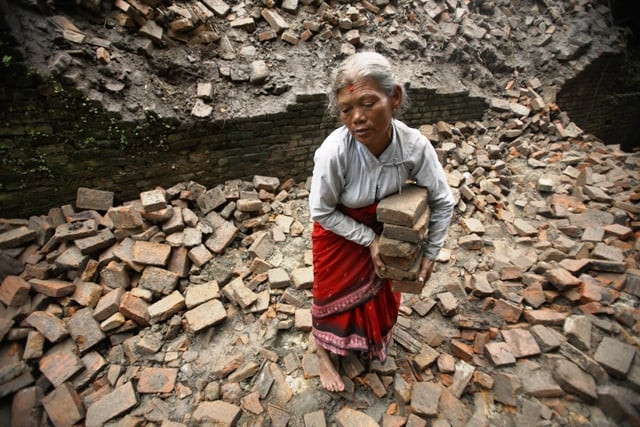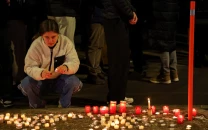Nepal quake survivors turn porters to deliver aid
Today, the operation is responsible for delivering aid to 40,000 quake victims

PHOTO: REUTERS
The 36-year-old is one of some 10,000 survivors of the disaster hired as porters to bring food, medicines and shelter materials to remote Himalayan villages cut off by the 7.8-magnitude quake that hit on April 25, killing nearly 8,900 people.
"I used to be a farmer, but now I have no farm, it's all gone," Thami told AFP, as she recounted the impact of the quake and massive aftershock that followed in May, which wiped out her village of Bigu in northeastern Dolakha district.
"We had no food to eat, we had nowhere to live -- it took about a week before help arrived," Thami said as she dropped off a 30-kilogramme sack of lentils for her fellow villagers.
The disaster destroyed roads, leaving villages like Bigu cut-off from vital supplies and creating a "logistical nightmare" for aid agencies, said Stephen Anderson, emergency coordinator for the World Food Programme, which is funding the scheme.
"This is some of the most challenging terrain WFP has operated in globally", Anderson told AFP.
"We desperately needed to access villages where choppers couldn't land either because of the steep terrain or the weather... we were facing an emergency," he said.
While the agency struggled to find a way out of the crisis, a small team of Nepali and foreign mountaineers made their way to the quake epicentre in Gorkha district.
Argentinian mountaineer Damian Benegas was on Mount Everest, planning to summit the world's highest peak for a sixth time when the disaster struck on April 25, triggering a deadly avalanche.
The 46-year-old climber arrived unscathed in Kathmandu six days later and travelled on to Gorkha, determined to help.
He considered hiring a helicopter to run air drops, but was deterred by the cost, which ran into thousands of dollars.
"We realised that we needed to approach this whole thing creatively.
"As mountaineers, we rely hugely on porters to move supplies and I thought we could do the same here, move more goods for a fraction of the cost of a chopper," he told AFP.
Over the next few days, the volunteers and villagers lifted rocks and cleared away debris in a bid to open up blocked mountain paths and begin the delivery of tents, blankets, food and water provided by non-profits.
By the time WFP suggested expanding the programme to cover other districts, Benegas and his fellow climbers had paid wages to around 1,000 villagers in Gorkha.
Today, the operation is responsible for delivering aid to 40,000 quake victims with climbers like Benegas assessing trails while Nepal's mountaineering and trekking associations organise porters' insurance and payments.
With April's quake hitting just weeks before the monsoon season, frequent downpours and rain-triggered landslides pose serious challenges to the porters' work, Benegas said.
"We fix a trail, then it rains and all our work is washed away, the trail simply disappears," he said.
The quake-hit trails were critical economic lifelines, connecting villagers with schools, medical facilities and markets.
Furthermore, in a country which has seen tourism take a nosedive since the disaster, officials say trail repair may hold the key to Nepal's recovery.
"It is essential that these trails are repaired so we can assure tourists about safety," said Ang Tshering Sherpa, president of the Nepal mountaineering association.
"We need people to go back to work... it is important to revive the tourism industry and make it safe for trekkers to visit."
Operations are set to expand further, with plans to employ thousands more porters and send relief materials to an estimated 100,000 people in the coming months.
Aid workers say they are in a race against time, battling monsoon rains even as worries about the approaching winter grow, fuelling concerns that heavy snowfall could bury restored trails and cut off villages once again.
"Winter's not far off at all and we need to move fast to open up access and help people stock up on food supplies... we are not out of the woods yet," WFP's Anderson said.
To quake survivors like Thami, fear is constant.
"There are aftershocks, there are landslides... out here, we don't know if (death) will come from above or destroy us from below," the mother of five said.
Nonetheless, she sets aside her anxieties and hits the trails before dawn every day in an effort to earn 1000 rupees per load and support her family's precarious existence on the isolated slopes.
"My husband is too sick to work so I have no expectations of him," she said.
"After going through two quakes and enduring so much pain, the fact that I am able to earn some money and send my children to school means everything to me."



















COMMENTS
Comments are moderated and generally will be posted if they are on-topic and not abusive.
For more information, please see our Comments FAQ